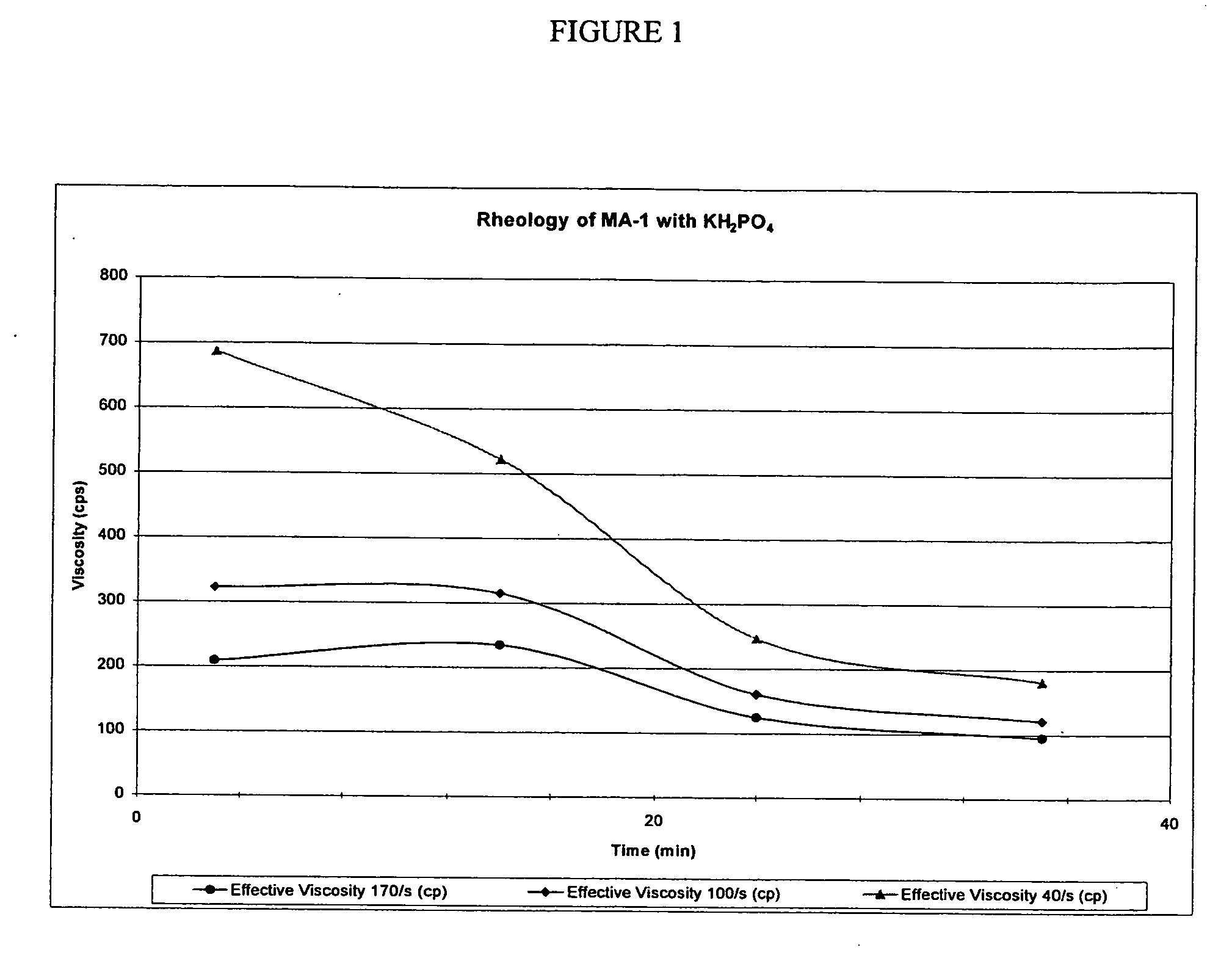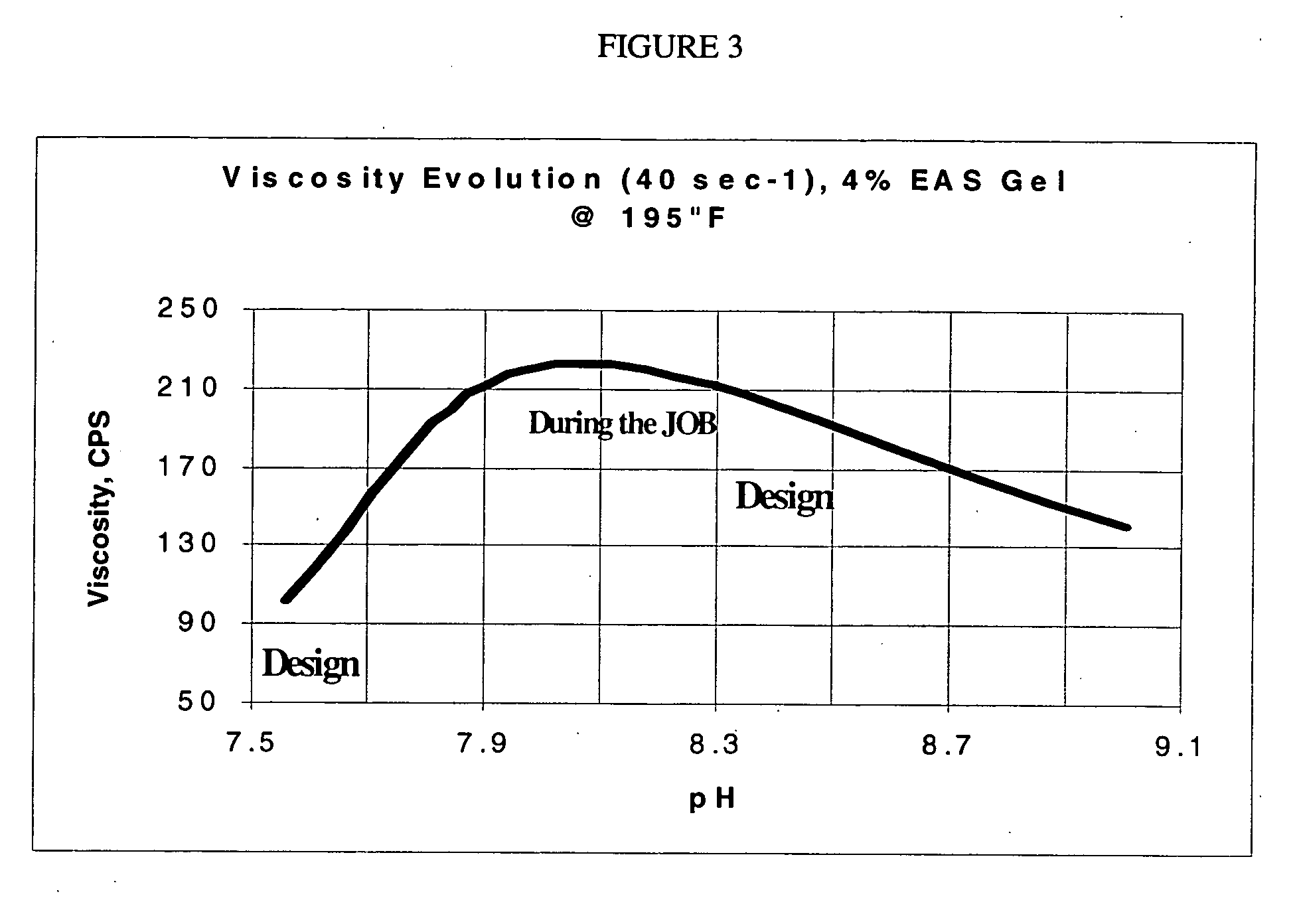Well service fluid and method of making and using the same
a technology of service fluid and well, which is applied in the direction of sealing/packing, chemistry apparatus and processes, and well accessories, etc., can solve the problems of increasing the amount of water produced from the well, reducing the water/hydrocarbon production ratio, and requiring remedial measures
- Summary
- Abstract
- Description
- Claims
- Application Information
AI Technical Summary
Benefits of technology
Problems solved by technology
Method used
Image
Examples
example 1
[0081] General Methods
[0082] Each of the components of the viscous fluids of the invention is readily soluble in water or light brines at pH higher than 4.5. The fluid is easily prepared in mixing equipment that allows circulation or agitation, i.e. blenders, tanks equipped with augers or tanks that are connected to a circulating pump, such as an acid transport trailer or in displacement tanks of cementing units.
[0083] A preferred mixing procedure is as follows.
[0084] 1) Load the fresh water necessary to prepare the desired volume of viscous fluid a clean tank.
[0085] 2) while agitating or circulating, slowly add and dissolve the required amount of the salt, for example, KCl, KF, KH2PO4 and / or K2HPO4.
[0086] The salt concentration will depend on the type of salt used and the final pH, as part of the “additional cations requirement for optimum viscosity as discussed above. The following table can be used as a guideline. Unless otherwise stated, the percentages are by weight of tot...
example 2
[0092] Fluids Containing Potassium Chloride
[0093] Formation pH: 8.0 at 180° F. (82° C.); design for a pH of 8.5 to 9.0 at the well surface. Fluid viscosity requirements=200 cps at 180° F. (82° C.) and 40 sec.
For KCl determination:KClpH gel at 80° F.Viscosity at% by(27° C.) + 0.4%40 sec and 80° F.4% MA-1 + 2% BF-7LweightEF-7L(27° C.), CPS4% MA-1 + 2.0% BF-7L108.512814% MA-1 + 2.0% BF-7L118.615654% MA-1 + 2.0% BF-7L128.617084% MA-1 + 2.0% BF-7L138.71512
[0094] The 12% KCl systems produced 285 cps at 40 sec−1 and a pH of 8.2 when tested at 180° F. (82° C.), therefore a system with 3.5 MA-1 may be sufficient for this treatment.
example 3
[0095] Fluids Containing Potassium Fluoride
[0096] Formation pH: 8 at 180° F. (82° C.); design for 8.5 to 9.0 at the well surface. Fluid viscosity requirements=200 Cps at 40 sec.
For KF determinationKClViscosity% bypH gel at 80° F. +at 40 sec4% MA-1 + 2% BF-7Lweight0.4% EF-7Land 80° F., CPS4% MA-1 + 2.0% BF-7L78.9114244% MA-1 + 2.0% BF-7L88.9522774% MA-1 + 2.0% BF-7L98.96996
[0097] The 8% KF system produced 452 cps at 40 sec−1 and a pH of 8.6 when tested at 180° F. (82° C.), therefore a system with 3% MA-1 may be sufficient for this treatment.
[0098] As indicated in the above examples, the formulations utilizing KF produce about twice the viscosity of similar formulations that contain KCl. However, KF is not available in all geographic locations. The formulations may use a combination of ammonium bifluoride (NH4HF2; ABF) and potassium hydroxide in order to produce KF in solution. Because the formulations are mixing cations (potassium and ammonium), it is more difficult to optimize t...
PUM
| Property | Measurement | Unit |
|---|---|---|
| temperature | aaaaa | aaaaa |
| pH | aaaaa | aaaaa |
| pH | aaaaa | aaaaa |
Abstract
Description
Claims
Application Information
 Login to View More
Login to View More - R&D
- Intellectual Property
- Life Sciences
- Materials
- Tech Scout
- Unparalleled Data Quality
- Higher Quality Content
- 60% Fewer Hallucinations
Browse by: Latest US Patents, China's latest patents, Technical Efficacy Thesaurus, Application Domain, Technology Topic, Popular Technical Reports.
© 2025 PatSnap. All rights reserved.Legal|Privacy policy|Modern Slavery Act Transparency Statement|Sitemap|About US| Contact US: help@patsnap.com



